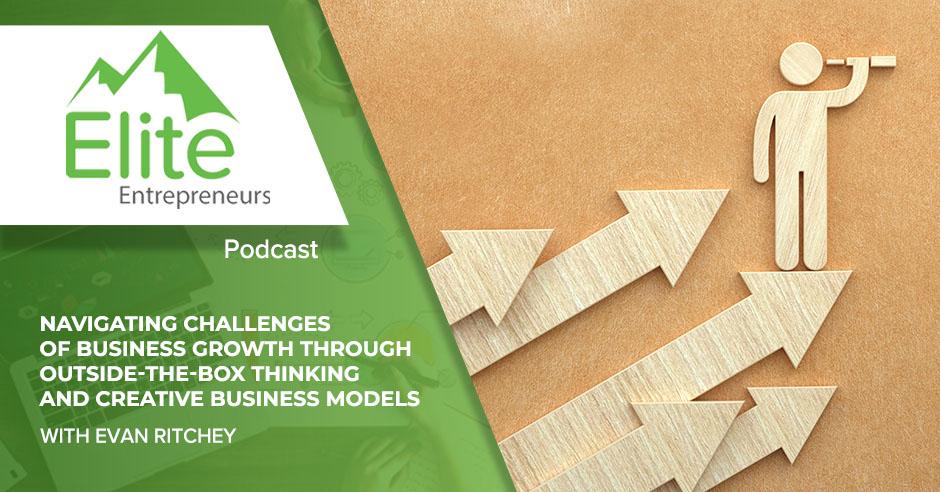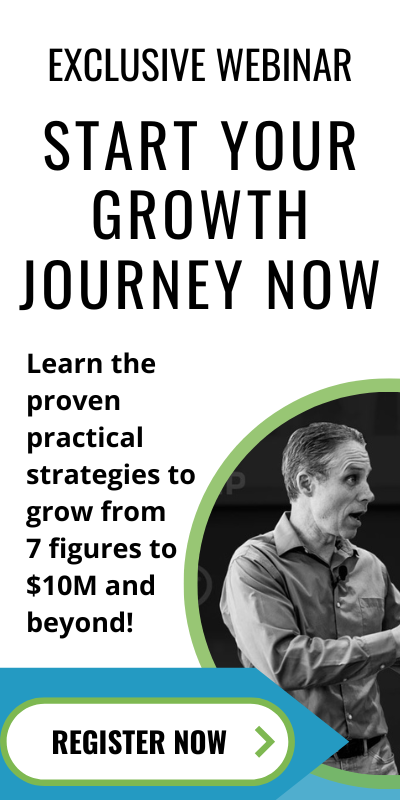Episode 148: Navigating Challenges Of Business Growth Through Outside-The-Box Thinking And Creative Business Models With Evan Ritchey
In a competitive industry with a customer base that already holds loyalty to established businesses, how do you insert yourself and stand out? For Evan Ritchey, the co-founder and CEO of Coconut Cleaning, the way in is through outside-the-box thinking: creative business models. In this episode, he sits down with Bret Gilliland to share how they navigated the challenges of starting a business in the cleaning industry through their unique cleaning process and subscription model. Going from two to 15 trucks, Evan then talks about how they built the team they have now and dealing with the effects of small business growth both financially and emotionally. The challenges of being an entrepreneur never end when you find success; it grows instead along with its rewards. Join Evan in this conversation and discover how being creative can help you face what’s coming your way and continue to thrive!
What the podcast will teach you:
- Doubling down on the subscription model could help grow your business.
- The art of letting go and trusting your people
- Balancing the successes of growing but also dealing with what that growth means
- The value of taking people’s ideas to the business’ culture
Resources:
- Evan Ritchey LinkedIn: https://www.linkedin.com/in/evan-ritchey-4398b610b/
- Coconut Cleaning Co Website: coconutcleaningco.com
- Coconut Cleaning Co Instagram: @coconutcleaning
- Elite Entrepreneurs: https://growwithelite.com/
—
Watch the episode here
Listen to the podcast here
I’m excited to introduce another amazing guest and I’m pinching myself with gratitude that we always have amazing guests on this show. We’ve got tons of awesome Elite Entrepreneurs out there who are sharing their real stories and their hard-earned lessons with all of us. We don’t have to go through all the same things, or we can at least have some insights and tips as we grow through those same stages with our business. I want to welcome Evan Ritchey to the show. Evan is the Cofounder and CEO of Coconut Cleaning. He has a profound love for all things business.
I wanted to share with all of you that he has an insatiable appetite for knowledge. That appetite is evident in his constant pursuit of personal and professional growth. You can find him engrossed in books to varying the wisdom shared by renowned business leaders and thinkers. He’s always pushing himself, which I highly recommend to all of you. I also want to share that he strives to empower others to unlock their full potential and chief success. He doesn’t know that it’s important for him to grow, but he’s bringing his people and others along with him for the ride. His time with us is no exception. I feel like we’ll treat this like you’re here, inviting all of us to grow and learn with you. Welcome to the show, Evan.
Thank you for having me on. I’m very excited to be here.
Why don’t you tell people about your business? I want to give a little airtime for you to explain a little history and tell us what Coconut Cleaning is so they have some context on your backs.
What I love about our business is in my early twenties and knowing that I always wanted to do entrepreneurship, I read that some of the best businesses to start have the most amount of customers or the most potential to reach the most amount of customers. A few years ago, I had exited working for a cleaning company and I was getting ready for medical school. What now is a business partner reached out to me and he said, “I’m doing pest control right now. We’re doing good. We’re about six years into doing this and we’re looking to start other service companies off of our already existing customer base that uses similar services.
They knew I had experience working in carpet and tile cleaning. What turned into what was originally like helping them get started, at the very end, they’re like, “Where do you want to start this?” I’m like, “I’m going to do medical school. I’m not touching another carpet cleaning wand again.” What made this unique in starting it is the carpet and tile cleaning industry is not accustomed to having a subscription-based model. Historically, the model is to get as much as you can and get out. It’s a unique industry and it’s not regulated.
Anyone can go and start a carpet and tile cleaning company without getting licensing and going through a funded process or program that says, “You have to meet this type of accreditation to be able to start your company.” It’s not regulated and we were able to start it relatively quickly. What we wanted to do differently than others was to go off of the pest control model and find a way to do this deep cleaning, but by winning customers over and getting them on a subscription-based cleaning process for their carpet, tile, upholstery, and area rugs, you name it.
Everyone needs that cleaning but they’re so used to and accustomed to, I asked my parents, this guy coming in saying, “I can also do this and this,” and then the tickets are $900 to $1,000. They never call that guy again. They’re always looking for someone new. We were committed to winning the customer over for a lifetime and having a cleaning process that they were extremely happy with and an employee base that they felt very comfortable with in coming into their home. That’s the nutshell of why we got started.
I love the whole conversation, but I’m intrigued about the medical school decision. You left this with a cliffhanger there. Obviously, you stayed with the business. Do you still have any desire to go down that path at some point?
I was working. What’s interesting about it is that there was a brief gap between leaving the cleaning company. It was about an eighteen-month gap and I was doing medical sales to make my resume look a little bit nicer for medical school applications. I ended up making a lot more money than I expected. I was like, “This isn’t bad.” I got a lot of firsthand experience with surgeons and I wanted to be a neurosurgeon. I wanted to go all in. I talked to 204 surgeons. 201 over that 18 months said, “Don’t become a doctor unless you want to from when you were a kid.
It’s become inundated with processes and the insurance is crazy now. The paperwork is crazy. The customers or the patients are crazy. Don’t do it.” I felt that I was getting very discouraged from doing medical school so that phone call from my now business partner was very timely because I had enough surgeons say, “Please, save yourself the time and don’t do it.” I was checking out but not knowing what I was going to do and then that phone call came in.
It’s fascinating how that all works out. Thanks for sharing that. Let’s get to the meat of our time together, which is you have a successful business. In fact, something we didn’t share is that we both live in and around the Phoenix metropolitan area and this is where you started this business, Coconut Cleaning. You have locations in four other markets across the US with plans to continue expanding. This is starting to grow quicker.
As you think back to the scaling point or an inflection point where it went beyond you and your business partner knowing how to do all the stuff, make it go, figure out the processes, and how you’re going to run this business to now it’s time to build a team in earnest and scale this thing. I want to go to that point in time roughly. Have you described some of the pains, challenges, or realities you were dealing with some of the day-to-day things as one of the business owners that were frustrating or difficult for you at that time?
It wasn’t as simple as we originally hoped. Green Mango Pest Control is my business partner’s business. They had beautiful ratings on the internet and thousands and thousands of customers. We thought that putting the Coconut flyer in their service packet would grow us exponentially, but people were still leery and hesitant. They’re like, “What if pest control people have any business operating in the cleaning world as well?” What we thought would be a shoo-in wasn’t exactly a shoo-in. We had to prove ourselves as someone in the market who was worth their time and their choice to go for in cleaning.

Creative Business Model: What we thought would be a shoe-in wasn’t exactly a shoe, and we had to prove ourselves as someone in the market who was worth their time and their choice to go for their cleaning.
What was the initial challenge? What’s our cleaning process going to be and how are we going to differentiate ourselves from other people in a cleaning world? It is a shoo-in with Green Mango customers because they’re like, “I’ll give you a shot,” but I found out very quickly that in this cleaning industry, people are very loyal to the Stanley Steemer, the Chem-Dry, or the Zerorez. They have their company and they don’t want to switch. Some initial hurdles were more than being a clean-cut brand. Is our cleaning going to be better and superior than others and how are we going to get it there?
I would say the first six months were probably serving a lot of influencers, like people on social media, and a lot of Green Mango customers. A lot of trial and error through, “We’re going to clean your carpet this way. We’re going to clean your tile this way. Do you want to see us every 6, 3, or 9 months?” We’re trying to figure out that subscription model and what our customers were looking for. I know that it was difficult for my partner to say, “This isn’t working as well as I thought it would. I’m going to give you six more months to try to make something of this, and if you can’t do anything with it, then we’re probably going to shut it down.
It’s because it’s not worth us hurting our Green Mango customers if people at Coconut aren’t going to have a premium state experience with cleaning.” I got creative and went back to the drawing board. I put down a few things that I wanted us to be known for, and that was one or low impact as far as the solution that we use. We ended up creating a chemical process that’s proprietary to Coconut, but we only use a coconut surfactant during our cleaning process. It so happened that we’re Coconut Cleaning and people think, “The Coconut thing came first,” but we named ourselves Coconut Cleaning because of Green Mango Pest Control.
I found out that the coconut surfactant is a very green cleaning solution and it works extremely well on tile grout and carpet. We were able to make a proprietary solution that is activated by water and as soon as the water is gone, there’s nothing left behind. It’s leaving no residue and people who are used to the stiff, crunchy carpet don’t get that with our cleaning process. We’re finding a way for our subscription-based customers to benefit. How everyone subscribed to our services is we did four seasonal cleanings. That’s in summer, fall, winter, and spring. They pay a minimum of $99 for their seasonal cleaning, but they get 50% off for anything that they want done, which has never been done because this industry prides itself on a sectional the clean it and it’s $500.
I was telling these subscribed customers, “You can do a sectional for $200.” Now what happened is these customers rather than thinking that we’re trying to get these high tickets and run, we made our model off of, “We’re trying to get as much of your house done throughout the year as possible.” We found a very fiscally responsible approach to helping customers get their area rugs, carpet, tile, vehicles, and air ducts done for actual half-off pricing.
It’s not some cheap marketing trick a half-off pricing in. In the first six months, we did $100,000, then from 6th month to the 12th month, we did $450,000. That first year, we finished out around $500,000. What was funny is that even my business partner then was like, “That’s not good enough. You bought yourself a little bit more time, but we need to make it a little bit better.” What worked out great for us was COVID, actually. People became very germophobic during COVID.
They want everything clean and sterile.
Yes. The irony was they’d say, “We want you to come to our house and clean, but do you have to come inside? We don’t want anybody to come inside.” We’re like, “How do we clean?” They’re like, “Fine, just wear a hazmat suit.” We went from two vans in 2022 to 15 vans in one year. What worked great was hammering out that subscription model so that for every new customer we saw in 2020, we were able to get about 60% of them subscribed to our cleaning model. We made the whole process even better so that any Coconut Club member, anytime they refer somebody, their next cleaning is free. After their free cleaning, they can add a $50 credit to their cleaning. We’re showing up the houses with $400 or $500 credits and they don’t pay a dime.
We have people referring for business that helped drive down our acquisition cost. We’re able to allocate our marketing funds into different silos of marketing because we went crazy about making the experience for our customers feel like an absolute win. They were crazy if they weren’t referring, and then what we did with that excess funds is we doubled down on new silos of marketing to continue the growth on top of that. In year 3, we did $4 million. In year four, we did $5 million. In 2023, we’re on pace to do $5.5 million in revenue from making sure our customers felt like they were always winning with us.
That’s great. You’re the classic business owner because you keep going back to the customer, the market, and the model. I’m going to pull you back into some of the scaling lessons that you had to learn. Let’s get specific. You went from 2 trucks to 15 trucks. There are a lot of people involved. You had to hire people, build a team, and make sure there’s targeted coordinated action going on. It’s not a free-for-all. I’m sure it was chaotic for you to build those processes and to put people into that. I fully appreciate all of that chaos that must have been going on, but I’d like for you to describe what were some of the challenges around building this team that you have now.
I think some of the challenges that come to mind were detaching myself from everyone doing everything how I wanted it to be done. That’s a very vulnerable feeling to send people to your parent’s house. You got them on board, your sisters and brothers, and be like, “That high school baseball coach, when you were desperate for more customers that you call and said, ‘Can I come to clean your house?’ Now I’m sending employees to them.” It was a very vulnerable feeling to say, “Are my systems and my training sound enough that I feel comfortable sending all these people to people?” When I was desperate in those first six months, I called and asked for help and I said, “Give me a shot.”
Now I get the phone call. The baseball coach is like, “Are you too big to come to my house now?” I’m like, “I’m so sorry. I spread thin.” I remember a very vulnerable feeling of having these strangers to me put on a Coconut uniform and go through a two-week training process and then I sent them out to family friends and members. People that, in your entrepreneurial mind, “Those are my customers. Please take care of them,” but then also not being hyper-focused on the customer to the employee that the employee is like, “back off. I get it, I’ll take care of them.” You then get the phone calls where you feel guilty. You don’t want to feel guilty. It’s like my mom saying, “Why couldn’t you come out and do the cleaning?”
I’m like, “Mom, I’m a little busy, but how did Andrew do?” “He did good.” I’m like, “Okay, cool.” That was the first thing that came to mind. It’s the vulnerable feeling of letting go. I’m checking the training and most importantly the vetting process. I made sure that when I didn’t have the money, I still wanted to pay for the background checks and the drug screens. Those were so important to me. I made sure that I was at least in the upfront process that I felt comfortable with who I was hiring. The art of letting go and trusting people to take care of people that got you to where you were was a big deal for me.
The art of letting go and trusting people to take care of people that got you to where you are is a big deal for an entrepreneur. Share on XI do care deeply about my friends, my family, and sending people out to their homes. I don’t even know this person. I’m like, “I didn’t even train that guy. Sherry, do you trust him?” She’s like, “We have to.” I’m like, “I guess we have to.” That was a very vulnerable feeling. That’s what comes to mind first. Secondly, what comes to mind is it was extremely uncomfortable at least in that second to third year. I tried to create such a facade that we were doing so much better than we actually were because you inhale for a second the compliments that come your way of like, “I’m seeing your vans everywhere.” I’m like, “Heck yes,” but then I’m like, “We’re in debt up to our eyeballs because every van costs $100,000.”
I’m finding the capital to put up and get vans because banks were like, “You’re new. We don’t know you for that van. We want $40,000.” This is so uncomfortable for me because I didn’t want people to think we were outgoing our capital. Those first few employees that I would take out to dinner on a Friday night, I’m like, “What if we did McDonald’s?” However, I would try to present it in a way like we’re fine, but we truly weren’t. That was such an odd dichotomy to phase, which was our growth is doing so well that we’re running out of money. I don’t know how I’m going to pay payroll, but we’re on pace to do $3 million. I don’t understand what’s happening.
That was another very uncomfortable process for scaling, which was dialing in the model of bandwidth and knowing this threshold of this many new sales. I know that this many repeat customers are going to get service, and then I know that we’re going to have this much commercial accounts that I’m going to need another van. I have to prep another $40,000 to be ready to buy another van and I don’t have that. I’d go to my business partner and say, “What are we doing here?” We’re having to continually revise the model, revise our prices, and increase our prices because as the new company, my approach was like, “I want to take care of everyone.”
What normally is $45 for a room of carpet, I was charging $20 because I wanted people to get more done. I’m realizing taking care of people wasn’t taking care of my employees because I had to let go of a few people. I didn’t have the capital to keep paying everyone, but we were we were growing. That was a very odd feeling for me to say, “I can’t pay you, but your route is full for the next month.” We need to collect this cash faster and we need to stop growing so that I don’t have to buy another van. We’re getting to a point where you’re not buying another van but still growing and telling customers, “Thanks for giving us a shot. The early as we could see you was in three weeks.”
They’re like, “I’ll call Stanley. It’s totally fine.” That’s a sucky feeling too. I’m balancing the successes of growing but also dealing with what that growth means financially and emotionally. I did not know how to explain this to my friends and family. They’re like, “You should be grateful.” I’m like, “I am stressed and I am not happy because I don’t know how I’m going to pay for another van.” They’re like, “What are you talking about? You got a new building. You should be happy.” I kept having people say, “I should be happy,” but I didn’t feel it.
Balance the successes of growing but also dealing with what that growth means, financially and emotionally. Share on XThe total weight of that business and being beyond your available capital could support it. You grew your operations beyond the capital infrastructure and that’s not a fun place to be. How did you resolve that?
I remember it was Christmas Eve of 2020. My business partner had got a little UTV side-by-side for his kid. It was a ten-year-old appropriate one and he left it at the office. I was at the office because I was stressing out. He came to the office to pick it up because he had it at the office so his kid wouldn’t see it. It was 10:00 at night on Christmas evening, and he was like, “What are you doing here?” I’m like, “Cameron, I don’t know how we’re going to keep this amount of people and buy new vans without losing a lot of customers.” That subscription model was now eating me in the butt where I was like, “I have to service 500 customers this month. It is their service month but I don’t have the bandwidth for it as far as my vans.”
That night, I was like, “What if I added a second technician per van and then they could do four jobs? They could not do seven because that guy is going to shave off much time in helping set up the job, clean up the job, and service throughout the job.” On Christmas Eve of 2020, I was like, “I’m going to add a technician for every van,” and instantly, my bandwidth problems were gone. Every van was able to service 4 per day to 7 per day multiply that across 15 to 20 vans at that time and we were able to squeeze in an extra 200 to 500 jobs per month by adding a few $14 to $15 an hour positions to every van. Every job for us meant about $400. If we could squeeze in an extra 400 jobs per month at that $400 value, adding a few $15-an-hour employees wasn’t a problem.
That’s immediately where the bandwidth problem went away. It was adding a second technician per van. I’m convinced that it would have taken longer if I hadn’t tucked my kids in Christmas Eve, and then went to the office and to that drawing board. I was sitting there like, “I don’t know where we’re going to have more money. We don’t have more money for another van but the jobs are there. I can’t service about 300 customers on their service month because I don’t have more vans.” Adding those technicians, we put up a job posting on Christmas Day. I’d say by mid-January, I had fifteen technicians in each van. It’s an additional technician per van.
As far as your two-week training program goes, how was that?
It was up to the main technician who had already been here to accelerate the two-week training class. It turned into a two-day training process. We called all of our Coconut Club members that we were able to service. Ninety percent of them were like, “Don’t even worry about it. It’s the holidays. I don’t even know if I was going to have you guys come out.” I’d say January or February 2021, we were all caught up, at least, the bandwidth issues were gone because we were able to squeeze more revenue by adding a little expense for the employees.
It sounds like a little Christmas miracle back in 2020. That’s good. We’re almost three years later in 2023, how many vans do you have now?
We have we have 22 vans. Right now, we have fifteen operating. We’ve improved our model a little bit. We’ve upped our prices to be consistent with the bigger companies. We’ve lost a portion of that lower demographic of customers that were taking advantage of that $20 for a room or carpet, but our prices are now on par with the other big companies. We’ve lost the small volume of lower-paying jobs, but the retention is there with our Coconut Clubs and the types of customers that were brought on board now are okay paying that $45 for a room of carpet versus three years prior at $20. We have the extra vans now that we’re implementing into the air duct and commercial trucks down. It’s pretty cool to see.
The reason I asked about that is because I assume some growth came in a different way, but in that growth, I’m guessing now it’s not about a bunch of texts. Tell us about the formation, if there is one, of any leadership team as your company is growing.
It’s probably one of my favorite stories right now with Coconut. All within the same month, these four guys named Caleb, Trevor, Evan, and Jordan walked through the door, all to have a job before they went on to law school, medical school, and a few other professions. They didn’t know each other at all, but these guys were top-notch guys who all responded to a few postings from guys who already worked here and said, “It seems like a fun place to work. I’m not going to law school until next summer. I’ll go work there and earn some money.”
What ended up happening very fast is these guys fell in love with the environment and the culture, almost like I did with that medical sales job, but that was a $4 billion company and I wasn’t in love with the culture. I was in love with the paycheck. It’s a national company and I didn’t fall in love with it. If I probably would have fallen in love with the company, I don’t know if I would have stayed and gone to Coconut because the pay was great but I didn’t like the national side of it and it seemed like a headache. These four guys fell in love with like, “I love the culture and the environment. I love working with you, Evan.

Creative Business Model: I wasn’t in love with the culture. I was in love with the paycheck. If I probably would have fallen in love with the company, I don’t know if I would have stayed.
We all want to be in the same position and be your right hand. We want to grow this thing.” I found out very quickly that I didn’t have the positions for it because everybody wants off the van until they’re off the van, and then when they’re dealing with leadership things, they’re now, “I’ll go back on the van.” However, these four were very unique. They were the guys that when they came and cleaned your house, you’re like, “What are you doing working this job?” They looked like the doctors that they were preparing to be already. I said, “If I look into partnering with you guys, are you interested?”
All four said, “Yes,” but what I quickly realized is, “I don’t want to go into making partnerships and be responsible for all the cash that is required to start these businesses.” I know that we create a new LLC and then a bank would be like, “I don’t care what you’ve done over here. We don’t know who this LLC is. We want $40,000 to $50,000 for that van,” and then all the marketing that’s required. I spent nine months on the franchise process. I’d say November, the first one went out and those four guys have all gone out now. All of them are doing between $40,000 and $90,000 a month already in their respective location.
You found an expansion opportunity through your own talent pool to happen to find those guys. That’s a cool story. You’ve got your franchisor your franchising out opportunities in different markets. It sounds like you’re able to find some of those people, at least through your own hiring efforts.
What’s neat about Coconut is we’re approaching that six-year mark in September 2023. We have only had to create a job posting in the last two months, but up until that point, we never created a job posting. We always asked our guys to say it on Instagram. I’m like, “Can you say that your company workforce is looking for people?” At one point, we had five sets of brothers that worked here, but everybody knew each other because everyone’s friends or family came and worked here. It worked phenomenally for us.
We’ve already spent most of the time that we have to do this episode, but you briefly mention the great culture we have here and people enjoy being around it. I wonder if you have any nuggets for us about what it looks like from your perspective to create a great culture that people want to be part of.
Initially, it was a very lazy way of going about culture, but I’ve found that it’s not that bad, which is taking people’s advice on growing, what to do around the office and team outings, gifts, and things like that. Implement it and then give them the recognition. Very early on, I thought I was being lazy when someone said, “We should do this for cleaning the vans.” I’m like, “Everyone, Andrew said that we’re going to start doing this for cleaning the vans. I would give Andrew $500 for helping us implement something that changed our systems.” Slowly but surely, over the years, we have a company that 20 to 30 different people have built through their own sharing of ideas and actual execution of that thing.
When it’s executed, they want to see that thing come to fruition and prove themselves right. What’s great is that they’re naturally more receptive when their idea doesn’t work and hearing out anybody else’s ideas. As far as culture goes, I think a lot of people know what they want. If people know that, for a team outing area or a team break area, they want these massage chairs. It’s like, “Get the massage chairs. That’s a great idea. Can you shop some massage chairs and let me know?”
They’re like, “These ones,” and it’s like, “Great.” Now we have some massage chairs and they’re happy with it. More people are like, “This was Sherry’s idea,” and now more people are happy to prove to other people around here that their idea was good, and more people are bought into it. I thought I was being lazy having other people implement suggestions and then seeing it through, but it’s turned out to make something pretty cool here with everybody trying to validate their own ideas and see them come to fruition.
It sounds like a great opportunity to enroll people through their own creative engagement. They’re creating things by sharing ideas. They’re improving things and they feel this great sense of ownership all because you created an environment where they could contribute. You would roll with some of those ideas and everybody can see. It’s like, “Around here, they take our ideas seriously.” They welcome them. That’s cool.
What’s great too is that if they never did anything about it, they couldn’t complain. If they said they wanted a new TV, I said, “Could you shop out some cool TVs and let me know?” If they never let me know and don’t come back to me saying, “We didn’t get that cool TV,” they’re coming back to me two months later saying, “I dropped the ball. I got busy. Here are some TV ideas.” I’m like, “Okay, cool.”
The complaints went away almost overnight because people became responsible for seeing their own ideas come to fruition and they were more bought in and making it work. I said, “You have full autonomy to see that thing through. Let me know when you’re ready and I’ll get you a company card and we’ll buy it.” Some guys drove their ideas through some people and let it die. That proved to be wasn’t the best for that time.
Evan, medical school is lost was our game now. I am glad you didn’t end up as Dr. Ritchey, but you’re here with us sharing some of your own growth stories. If people want to learn more about Coconut Cleaning or connect with you on social, what’s the best way for them to do that?
They can always go to our Coconut Cleaning Instagram. I’m on social media but I’m still relatively private. I don’t think I’m very entertaining on social media, but they can always go to our Coconut website or our Coconut Instagram. We’re very much engaging with our customers. We’re constantly doing raffles. I think they’d find a lot of enjoyment there.
Thanks again for being our guest, Evan. I appreciate the time and the insights.
Thank you so much for having me.
That’s a wrap on this episode. If you know of other seven-figure business owners, please share the episode. Like it and do everything you can to make sure that as many seven-figure business owners as possible are getting wisdom from people like Evan we bring on this show so that you don’t have to reinvent the wheel. You can learn from all of their great experience and know some of the challenges that are coming as your business grows. Be with us next time.
Important Links
- Coconut Cleaning
- @CoconutCleaning – Instagram
About Evan Ritchey
 Meet Evan Ritchey, the CEO and co-founder of Coconut Cleaning. With a profound love for all things business, Evan’s dedication, drive and entrepreneurial spirit have propelled him to great heights in the business world.
Meet Evan Ritchey, the CEO and co-founder of Coconut Cleaning. With a profound love for all things business, Evan’s dedication, drive and entrepreneurial spirit have propelled him to great heights in the business world.
Evan’s insatiable appetite for knowledge is evident in his constant pursuit of personal and professional growth. You can often find him engrossed in books, devouring the wisdom shared by renowned business leaders and thinkers.
Evan strives to empower others to unlock their full potential and achieve success. His belief in the potential of every individual fuels his desire to create a positive impact in the lives of those he encounters. With Evan at the helm, Coconut Cleaning is poised for continued growth and success, driven by a shared vision and an unwavering commitment to provide a premium service and experience for all Coconut customers.
Want to listen to more? View all episodes here >



